You're staring at your Facebook Ads dashboard at 2 AM, watching your ROAS tank, and your first instinct is probably to slash your ecommerce ad spend.
After all, if the ads aren't working, why throw more money at making more ads, right?
But here's a question that might keep you up even later: What if the problem isn't that you're spending too much on ads, but that you have no clue what the right amount actually is?
Most brands I work with are flying blind on this.
They'll agonize over whether to spend $3,000 or $5,000 on a new video series, but they can't tell you if that investment will actually move the needle on their bottom line.
They're making creative budget decisions based on gut feelings, competitor stalking, or whatever their agency recommends.
Meanwhile, the brands that crack this code?
They're the ones scaling past everyone else while their competitors are stuck in the same revenue plateau, wondering why their "winning" ads stopped winning.
The difference isn't luck or better creative instincts.
It's that they've figured out the financial framework that connects creative spending to actual business outcomes.
So today, we're focusing on the question that keeps every ecommerce founder awake: How much should you actually be spending on creative (content + ad spend), and how do you know if it's working?
Why Your Creative Budget Needs a Financial Framework
Think about your creative assets like your sales team.
Every ad you're running? That's essentially a salesperson working for you 24/7.
Some are smooth talkers who can close anyone. Others are great at getting attention but terrible at closing the deal.
And some are just... well, they're the ones you probably should have fired months ago but keep around because they occasionally make a sale.
Now, if you had a sales team of actual humans, you'd never just throw money at hiring more people without knowing what each salesperson was bringing in, right?
You'd want to know:
- Who's your top performer?
- Who can handle the biggest accounts?
- Who craps out when you give them a bigger territory?
But somehow, when it comes to creative, we just... wing it.
Here's what I've noticed after working with hundreds of ecommerce brands: The ones who actually scale don't just create "better" ads.
They create ads that do three specific things that directly impact their bank account.
First, they boost your average order value.
Maybe it's selling a bundle instead of a single product.
Maybe it's convincing someone to grab the premium version.
Maybe it's getting a subscription buyer to commit to six months instead of going month-to-month.
Second, they lower your customer acquisition cost.
These ads convert more people at the same spend level, or they convert the same number of people for less money.
And third - this is the big one most people miss - they can scale to higher spend levels without falling apart.
You know that ad that was crushing it at $100 a day but died when you tried to push it to $300? Yeah, that's not a winner. That's a tease.
The ads that actually build businesses are the ones that keep performing as you pour more money into them.
Now here's where it gets interesting.
Most brands obsess over ROAS because it feels like the ultimate scorecard. Hit your target ROAS, and you're winning, right?
But what if I told you that chasing ROAS might actually be keeping you broke?
Stay with me here, because this is where we need to talk about a different way to look at your numbers...
The Problem with ROAS
Picture this scenario: You're running ads at an above average 4x ROAS, spending $250k a month, bringing in $1 million in revenue. Life is good.
Then Zuck decides to mess with the algorithm, and your ROAS drops to 3x overnight.
What's your first move?
If you're like most brand owners, you panic and think: "My target ROAS is 4x, so I need to cut ad spend to get back to that number."
So you slash your ad spend from $250k to $150k. Boom - your ROAS climbs back up to 4x. Mission accomplished, right?
Here's the thing: You just made your business worse.
Don’t believe me? Look, when you cut that ad spend, sure, your ROAS looked prettier.
But you also sold way less stuff overall.
And all your fixed costs - your rent, your salaries, your software subscriptions - they don't give a damn about your ROAS.
They still need to be paid whether you're crushing it or bombing.
This is where ROAS starts lying to you.
It tells you how much revenue you're generating per dollar of ad spend, but it completely ignores whether that revenue is actually enough to keep your business alive.
What you really need to know is: After paying for your products, your ad spend, your shipping, your transaction fees, and all the other costs that go up when you sell more stuff - how much cash is actually left to cover your fixed expenses and generate profit?
That number has a name: contribution margin.
Think of it like this: contribution margin is the cash you have left after paying all your variable expenses.
It's what you use to cover your fixed costs like payroll, rent, and software.
And if your contribution margin isn't big enough to cover those fixed costs? Congratulations, you're losing money - no matter how pretty your ROAS looks.
Here's why this matters for your creative budget
The brands that understand contribution margin make completely different decisions than the ones chasing ROAS.
When their ROAS drops, instead of cutting ad spend, they might actually increase it.
Sounds crazy?
Let me show you the math...

Now look at those numbers and tell me: Would you rather have a 4x ROAS and lose $30,000, or a 2.65x ROAS and basically break even?
This is exactly why brands that obsess over ROAS get stuck. They make decisions that look good in their reporting dashboards but kill their actual business.
And here's where your creative budget comes into play: If you don't understand contribution margin, you're probably making the same mistake with your creative investments.
You might be cutting your creative budget because your ROAS is down, when what you actually need is better creative that can perform at higher spend levels.
Or you might be throwing money at creative without any clue whether it's actually moving the needle on the only number that matters: how much cash you have left after all the dust settles.
The brands that crack the scaling code?
They've figured out something I call "Creative Contribution Margin" - a way to directly connect every dollar they spend on creative to the actual financial impact it has on their business.
And once you see how this works, you'll never look at your creative budget the same way again...
The Creative Contribution Margin Method
When you hire a creative strategist, work with better creators, or invest in higher-quality scripts, you're not just buying "more creative."
You're buying the ability to unlock higher contribution margins.
Think about it: What does winning creative actually do for your business?
It lets you spend more money on ads while maintaining (or improving) your economics.
That $100k/month ad spend ceiling you've been stuck at? Better creative can break through that ceiling and let you scale to $150k, $200k, or even $500k while still hitting your profitability targets.
But here's where most brands screw this up: they invest in creative without any framework for measuring whether it's actually working.
They'll spend $5,000 on a new video series and judge success based on whether their ROAS improved or their CPM went down.
But they never ask the only question that matters: Did this creative investment increase my contribution margin enough to justify the cost?
Let me introduce you to a concept that most brands completely ignore, but it's probably the biggest factor determining whether you can scale or not: CAC scaling increment.
Here's what I mean:
Let's say you're running ads with a $30 CAC at $10k/month in spend. Life is good.
So you decide to double your spend to $20k/month. What happens to your CAC?
In most cases, your CAC will go up. Maybe it goes to $32. Maybe $35. Maybe it jumps to $45 and you quickly scale back down because the economics don't work anymore.
This isn't some quirk of the Facebook algorithm. It's basic economics. When you increase spend, you're either:
- Reaching into less targeted audiences (higher CAC)
- Bidding against more competition (higher CAC)
- Hitting creative fatigue faster (higher CAC)
- Running up against natural audience size limitations (higher CAC)
Your CAC scaling increment is simply how much your customer acquisition cost increases as you scale your ad spend. And this number varies wildly from ad to ad.
Some ads can handle massive spend increases with barely any CAC degradation.
These are your scaling goldmines - ads that appeal to broad audiences and don't fatigue quickly.
Other ads are beautiful at small spend levels but fall apart the moment you try to push them harder. These are scaling traps that keep you stuck at low spend levels.
Let me show you what this looks like with real numbers:
Let's say you have:
- AOV: $90
- Starting CAC: $30
- CAC scaling increment: $1.25 per $50k spend increase
So at $50k/month spend, your CAC is $30. At $100k, it's $31.25. At $150k, it's $32.50. And so on.
This might seem like small increases, but watch what happens to your contribution margin as you scale:
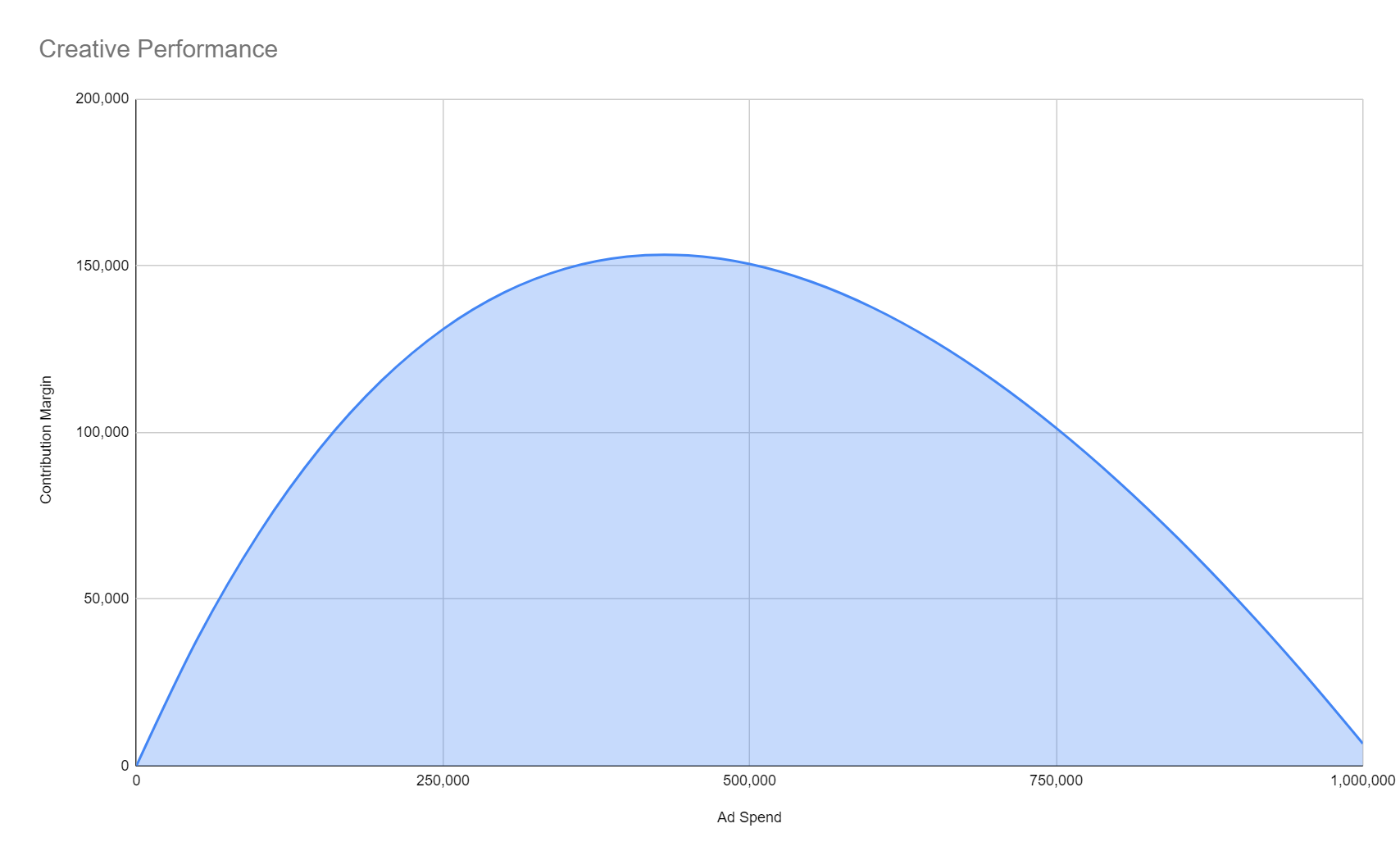
Look at that curve: You start at zero, and as you increase ad spend, your contribution margin climbs steadily.
You hit your peak around $450k in ad spend - that's your sweet spot where you're generating maximum contribution dollars.
But here's the key insight most brands miss: You don't have to stop at the peak.
Past $450k, your contribution margin starts declining, but you're still profitable. You're still generating positive contribution margin - it's just not as much per dollar spent.
This creates an interesting strategic decision: Do you optimize for maximum contribution margin (stay at $450k spend) or do you optimize for maximum customer acquisition (scale higher even though it's less efficient)?
If you're in growth mode and you have the cash flow to support it, scaling past the peak might make perfect sense.
You're acquiring more customers, building a larger base for retention and LTV, and potentially gaining market share from competitors who are too focused on short-term efficiency.
Let's Spend Some Money
So, let's say now we decide to invest in creative.
In the baseline scenario, we didn’t invest in anything.
So, let's say now we decide to invest in creative. In the baseline scenario, we didn't invest in anything.
Now we're going to add some creative investments:
- $8,000/month for a creative strategist
- $600/month in additional creative costs
- 5% of our ad spend going to creators, scriptwriters, and production
So at $300k monthly ad spend, we're investing about $23,600/month total in creative ($8,600 in fixed costs plus $15,000 which is 5% of our $300k spend).
No Improvement Scenario (Losing Money)
But what if we make these investments and don't improve our creative or financial metrics in any way?
Well, now we have a problem. We're spending an extra $23,600/month but getting zero improvement in AOV, CAC, or scaling ability.
Look what happens to our curve:
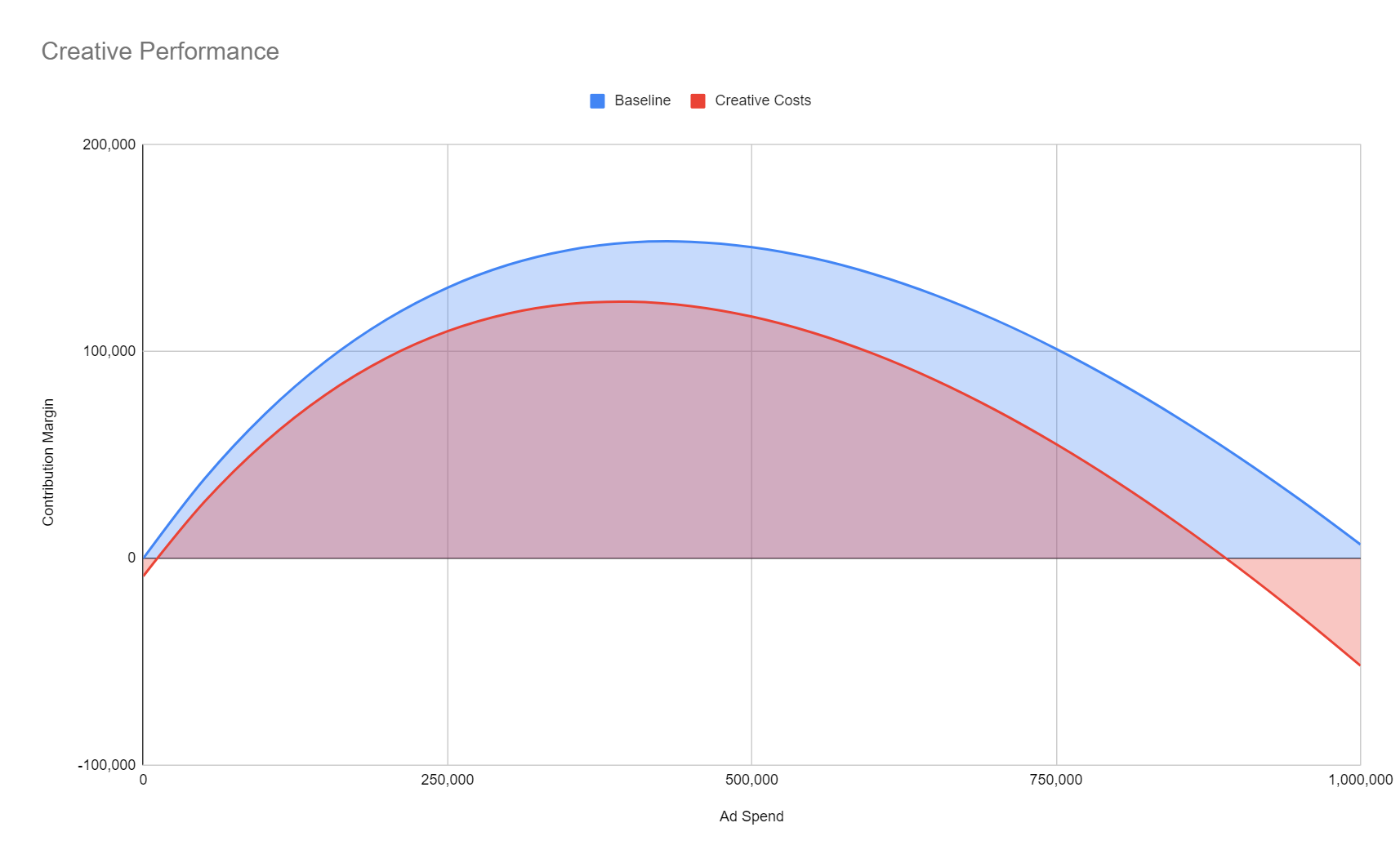
Instead of starting at zero contribution margin when ad spend is zero, we're now starting at negative $8,600 (because of those fixed creative costs).
And because 5% of every ad dollar now goes to creative instead of generating orders, our entire curve shifts down.
We still peak somewhere around the same ad spend level, but our maximum contribution margin is significantly lower.
Plus, we hit our break-even point much earlier - we can't scale as high before we start losing money.
This is creative investment without creative performance improvement. It's just expensive decoration.
Breaking Even Scenario
But here's where it gets interesting: What's the minimum improvement we need to just break even on this creative investment?
Let's say we need our creative investment to at least pay for itself.
If we're spending an extra $23,600/month on creative, we need that to generate at least $23,600 more in contribution margin.
Running the math, if we could improve our AOV from $90 to about $95 - just a $5 increase - that would generate just enough additional contribution margin to break even on our creative costs.
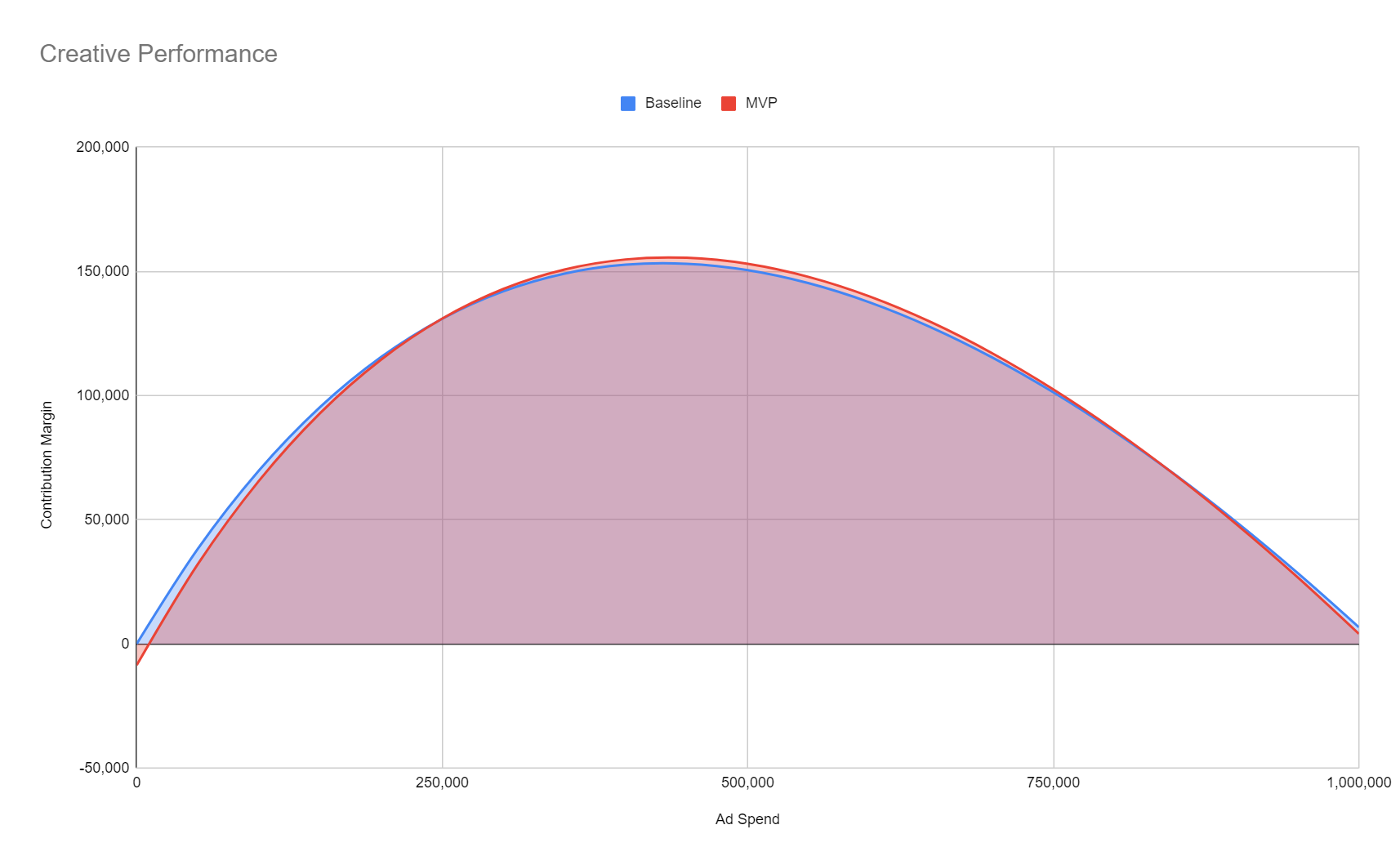
Winning Scenario
But what if we do better than that?
What if our creative investment helps us boost AOV from $90 to $100?
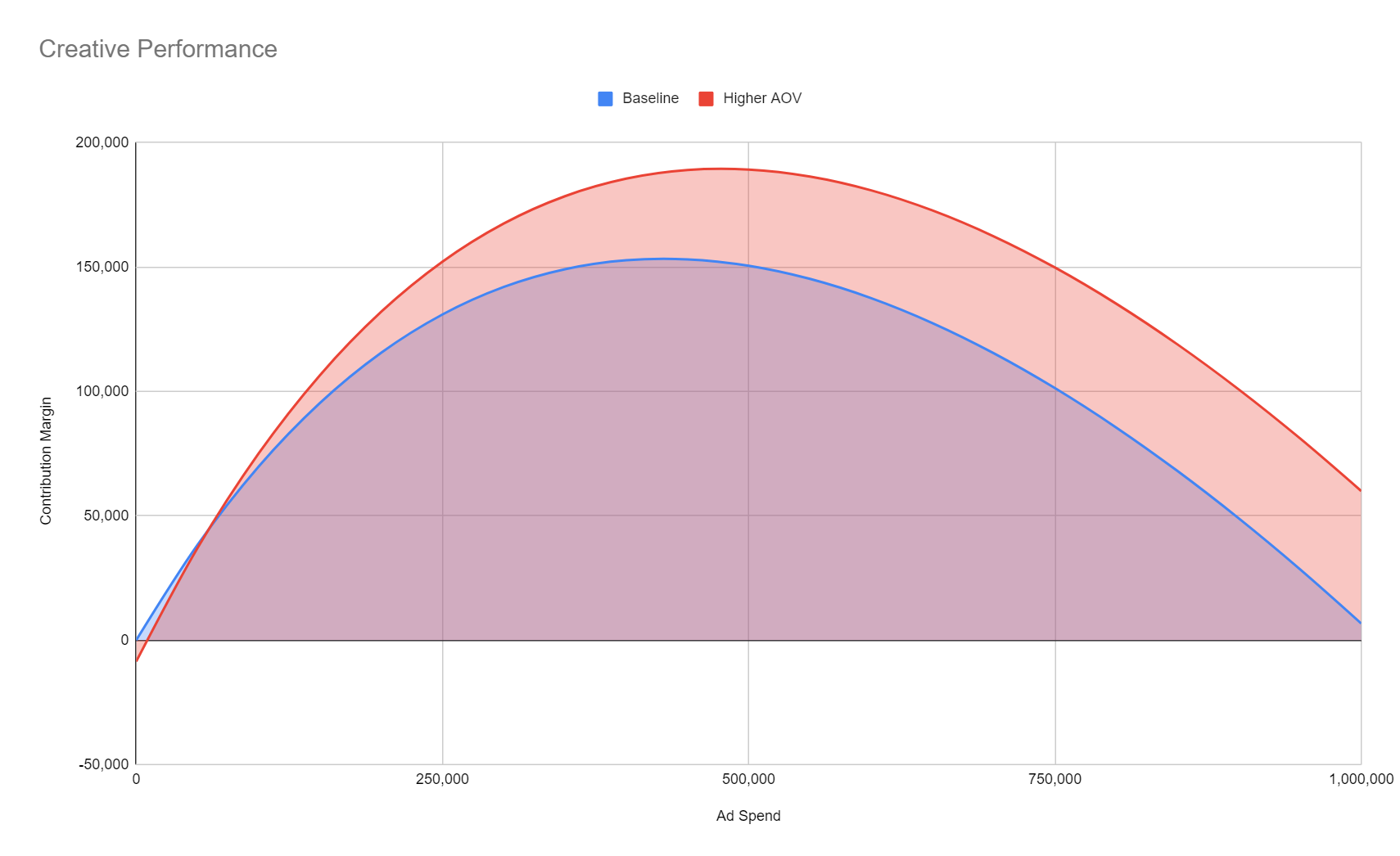
Now we're not just breaking even - we're generating significantly more contribution margin at every spend level.
Our curve shifts up dramatically, and we can scale much higher before hitting break-even.
Or what if instead of improving AOV, our creative helps us improve our baseline CAC from $30 to $27?

Same result - massive improvement in our contribution margin curve.
But here's the real magic: improving your scaling ratio.
What if our creative doesn't change our starting AOV or CAC, but it appeals to much broader audiences and doesn't fatigue as quickly?
Instead of our CAC increasing by $1.25 for every $50k spend increment, maybe it only increases by $0.75.
This gives you the biggest improvement of all. Your curve doesn't just shift up - it extends much further to the right!
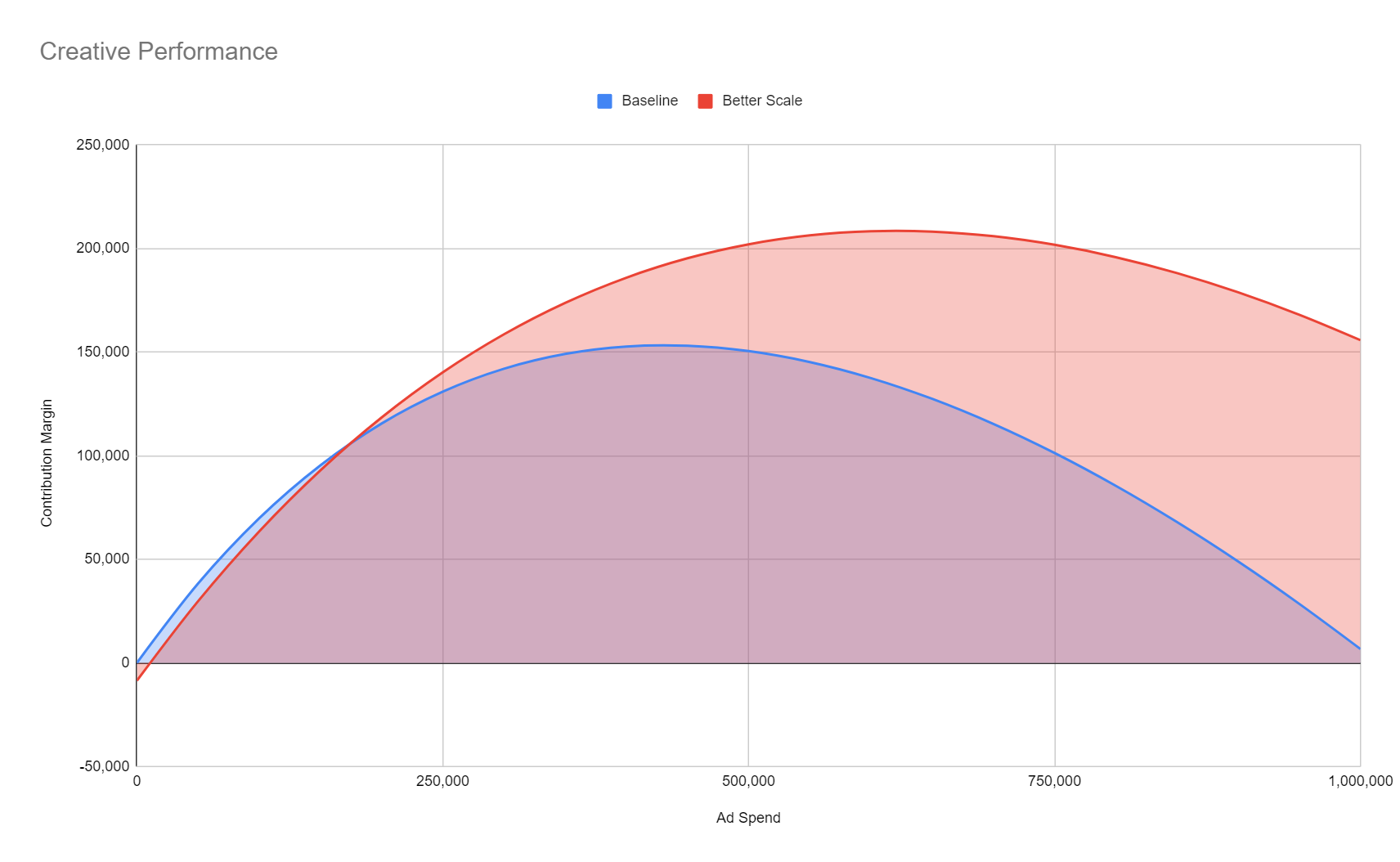
You can now scale to $650k, $800k, or even higher spend levels while maintaining profitability.
This is what I call your "creative-to-scale ratio," and it's probably the biggest lever you have for continued growth.
The brands that seem to effortlessly scale past everyone else? They've figured out how to create content that maintains performance as spend increases.
But how much should you pay for creating that content?
How Much To Spend on Producing Ads?
After working with hundreds of ecommerce brands, I've found that the ones who crack the scaling code typically invest between 5-10% of their ad spend on creative strategy and generation.
Spending $100k/month on ads? You should probably be investing $5k-10k/month on creative.
But like every rule worth following, this one has some important exceptions.
When you're spending less than $50k/month on ads, you might need to spend way more than 10%.
Here's why: If you're only spending $5k/month on ads, 10% gives you a whopping $500 for creative. Good luck finding a decent creative strategist who'll work for $500/month.
At lower ad spend levels, you're often still searching for that initial creative breakthrough - those first few winning ads that can actually get you some real traction. You haven't found your creative-market fit yet.
You might need to spend 15%, 20%, or even 30% of your ad spend on creative to find those initial winners that unlock your first real scaling opportunity.
Because here's the brutal truth: there's no point optimizing ad spend efficiency if you don't have creative that can actually convert at scale.
I've seen brands spending $10k/month on ads invest $4k/month in creative and finally break through to $50k+/month because they found that one creative angle that resonated.
That 40% creative investment looked crazy on paper, but it unlocked 5x growth.
When you're spending $1 million+ per month, you probably don't need to hit that full 10%.
At $10 million/month in ad spend, following the rule strictly would mean spending $500k-1M monthly on creative. That's not about testing 500 pieces of UGC every week - that's just wasteful.
At that scale, you're better off investing in higher-quality creative:
- Work with well-known creators who have their own followings.
- Partner with celebrities or influencers who can create content with much broader appeal and longer shelf life.
- Invest in production values that make your ads feel more premium.
Quality over quantity becomes your mantra.
But here's the real key that most brands miss: The percentage matters way less than whether your creative investment is actually improving your contribution margin.
I've seen brands spend 15% of their ad spend on creative and get incredible returns because they found creative that could scale to much higher spend levels without performance degrading. Their creative investment unlocked massive scaling ceilings.
I've also seen brands waste 3% because they were creating content that looked pretty in their Slack channels but didn't move any of the metrics that actually matter to their business.
Beautiful creative that converts exactly the same as their existing ads.
The question isn't "Am I spending the right percentage on creative?"
The question is "Is my creative investment unlocking higher contribution margins through better AOV, lower CAC, or increased scaling capacity?"
Here are the warning signs your creative budget is too low:
- You've been stuck at the same ad spend level for 3+ months
- Your ads fatigue quickly and you're constantly scrambling to find new winners
- You can't scale past certain spend thresholds without your economics falling apart
- You're constantly battling rising CACs with no way to improve efficiency
- Your competitors seem to be scaling effortlessly while you're stuck
Here are the warning signs your creative budget is too high:
- You're investing heavily in creative but not seeing improvements in AOV, CAC, or scaling ability
- You're creating tons of content but most of it performs the same as your existing ads
- You're more focused on production value and aesthetic than on the strategic elements that actually drive performance
- You can't clearly connect your creative investments to business outcomes
You Can't Optimize What You Can't Measure
Here's the uncomfortable truth about everything we've discussed: None of this works if you don't have clean books and accurate numbers.
You can't calculate contribution margin if you don't know your true COGS. You can't measure creative ROI if your ad spend isn't properly categorized. You can't track CAC scaling increments if your customer acquisition data is scattered across different platforms with no single source of truth.
I see this all the time - brands trying to make strategic decisions based on messy data.
They're pulling revenue numbers from Shopify, ad spend from Facebook, shipping costs from one place, transaction fees from another, and trying to piece together their real profitability in some Frankenstein spreadsheet that breaks every time they update it.
Then they wonder why their "profitable" campaigns are somehow not generating cash flow, or why their books don't match their dashboard numbers.
You can't build a house on a shaky foundation, and you can't build a scalable ecommerce business on messy books.
If you're tired of making marketing decisions based on incomplete data, or if you want to actually implement the contribution margin analysis we've been talking about but don't know where to start with cleaning up your numbers, that's exactly what UpCounting specializes in.
We help ecommerce brands get their books clean, their numbers accurate, and their financial reporting set up so you can actually make these kinds of strategic decisions with confidence.
In the meantime you can try out our calculator with your own numbers right here.



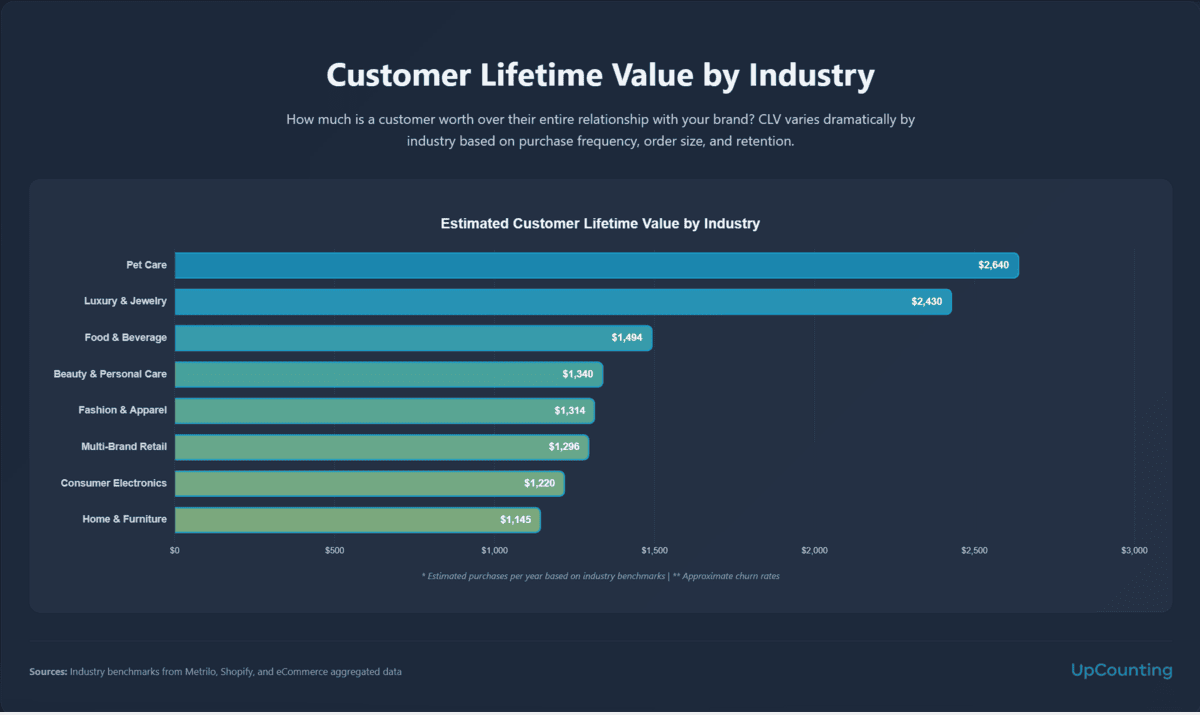
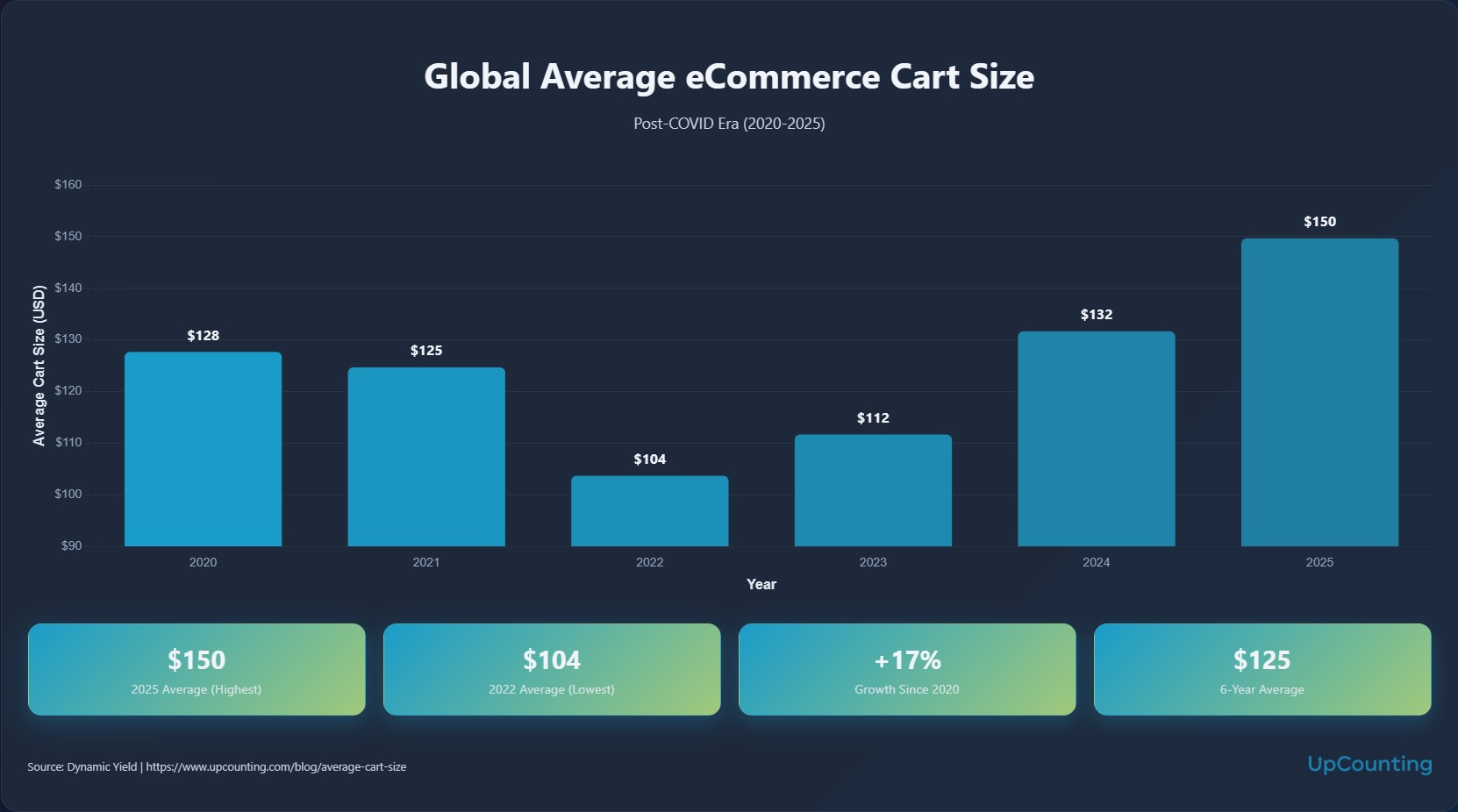

.jpg)







.jpg)
